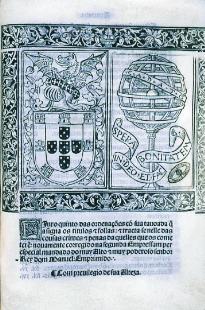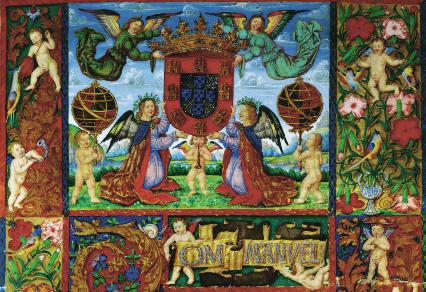

Almost from the start the royal coat of arms displayed a coronet at the upper
edge of the shield, which from the time of D. Sebastião onwards was replaced by a
royal or, occasionally, an imperial crown. 61
The armillary sphere
The armillary sphere was the insignia granted to King Manuel by his brother-
in-law and predecessor, King João II, an act of mystery and prophecy as it gave him
hope in his royal succession. 62
Devices or emblems are the (insignia) that kings, princes and private individuals
use, reconciling the images and letters with the design and the intentions that each
one has to achieve great deeds
. 63
In reality the device is represented by a symbol, usually with a legend or motto
chosen by the individual concerned as a guiding light for his actions and for his life.
According to King Duarte, the device, ‘like a person, that has a soul and a body’, is also
formed of two distinct parts: a soul and a body. 64
The acceptance of these emblems from the second half of the fourteenth
century, and reaching its peak in Portugal and most of Europe in the fifteenth century,
arose as a reaction to the fact that arms had become an identification symbol for an
entire lineage, losing their personal nature, as Henrique Avelar and Luis Ferros rightly
stated. 65 And this personal nature is contained in the device.
After 1504 King Manuel systematically associated the Portuguese coat of arms
with the two spheres, which became part of his emblem. The sphere has five parallel
rings – representing the Equator, Tropics of Cancer and Capricorn, Arctic and Antarctic
– the depth being suggested by a meridian drawn in perspective and by the band that defines the
ecliptic. This band is used to inscribe the name or initials of the monarch (sometimes misspelled), the
signs of the Zodiac, or the motto
Spera in Deo
(Trust in God). The sphere is occasionally badly designed,
has one parallel too many, or is missing altogether. 66 Depictions of the armillary sphere, as in the prints
of the
Ordenações Manuelinas
(Manueline Laws) that replaced the legislative body of the Afonsine era,
sometimes display a band with the motto of the device: ‘
Spera in Deo et fac bonitatem
’ (Trust in God
and do good), inspired by Biblical teachings and referring to Psalm 36:3: ‘Trust in the Lord, and do good,
and dwell in the land’ (fig. 10).
The association of the power of God with the royal power of the king is usually achieved by two
or more angels on either side of the coat of arms, fulfilling the dual role of heraldic figures, called
supporters, representing the guardian angels of Portugal, 67 and celestial figures. Sometimes there are
direct references to the divine presence: a single angel, St. Michael, the angel of Portugal; God the
Father who appears in heaven; the royal theme of the evangelists Sts. John and Luke; the face of Christ
and the IHS monogram (fig. 11).
PORCELAIN OF THE YUAN (1279–1368) AND MING (1368–1644) DYNASTIES
. 131
61 Mattos, ibid., p. 95.
62 Resende, 1973, pp. 70–71.
63 Francisco Rodrigues Lobo, 1619,
quoted by Avelar and Ferros, 1983,
p. 227.
64 Quoted by Henrique Avelar e Luís
Ferros, ‘As Empresas dos Príncipes da
Casa de Avis’, in
O Homem e a Hora
São um Só, A Dinastia de Avis,
exhibition catalogue, XVII Exposição
Europeia de Arte, Ciência e Cultura,
Casa dos Bicos, 1983, p. 227.
65 Avelar and Ferros, ibid.
66 Alves, ibid., p. 129.
67 Langhans, 1966, p. 40.
Figure 10. Engraving with the royal coat
of arms and the armillary
sphere. Front page in Books 1,
2 and 5 of
Ordenações
Manuelinas,
1514 edition
© ANTT/José António Silva
Figure 11. Illuminated manuscript with
armillary sphere, the
Portuguese royal coat of
arms, angels and vase with
IHS monogram.
Leitura Nova 6
, book 1 of
Beira
© ANTT/José António Silva